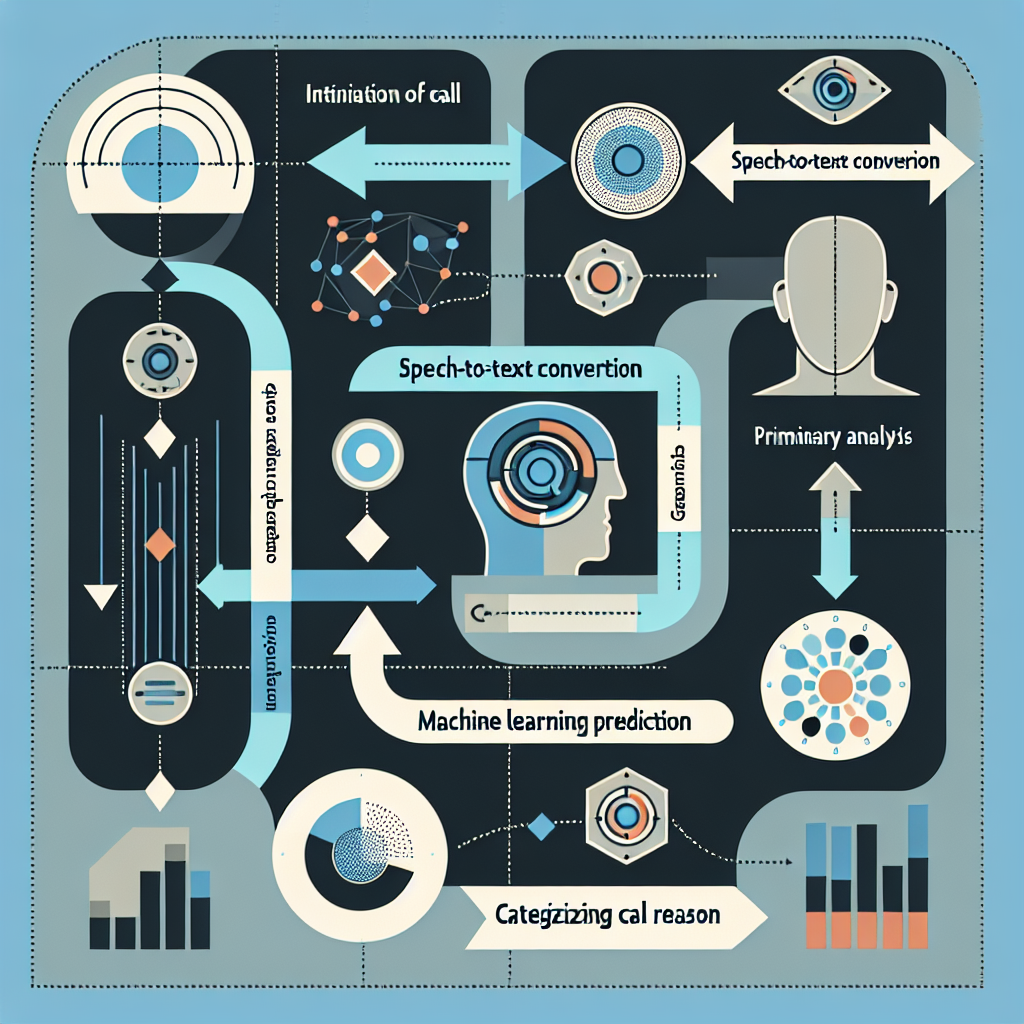
In the fast-paced and tech-driven world of customer service, artificial intelligence (AI) has taken center stage with its immense potential to revolutionize how companies interact with their clients. Among the variety of AI applications, one that is swiftly gaining prominence is Automated Call Reason Prediction.

As the name implies, automated call reason prediction is a technique that utilizes machine learning to predict the probable reason a customer is calling customer service. Though this futuristic concept might seem straight out of a science-fiction movie, it is a reality many modern businesses are rapidly embracing. The software 'learns' from a series of previous calls and analyses patterns to predict the reason for a new incoming call. Once the prediction is made, the agent is automatically provided with relevant information, thus helping them handle customer issues more effectively and efficiently.
This technique has a significant advantage in the modern customer service environment. With the prevailing trend of customers seeking instant resolutions, automated call reason prediction can speed up call handling times. By arming agents with pertinent information before the conversation even begins, it enables them to significantly reduce the customer waiting time, thus improving overall customer satisfaction.
The importance and benefits of automated call reason prediction do not end with just improving customer interaction. It also maximizes the productivity of customer service agents, thus enabling them to manage their workload better. Accurate predictions result in faster problem resolution, which in turn decreases the call volume and lightens the load on the agents.
In conclusion, automated call reason prediction promises a future where delay is a term as archaic in customer service as a rotary dial telephone. As this technology continues to evolve, businesses need to ensure they adapt to remain competitive.
In the dynamic world of customer service, Automated Call Reason Prediction is becoming increasingly crucial in providing enhanced and proactive customer assistance. By anticipating the customer's query before they even vocalize it, agents can prepare themselves with the appropriate knowledge and skills, in turn improving the overall customer service experience. The core technologies making this possible are sophisticated Artificial Intelligence (AI) and Machine Learning algorithms.
AI applies advanced algorithms and mathematical models to autonomously interpret, learn from, and make predictions based on call data. This allows the system to identify patterns and trends, such as why a customer might be calling. It all starts with Natural Language Processing (NLP), a subfield of AI that processes and understands human language. DeepAI's overview provides an excellent rundown of this technology.
Following the initial data interpretation by NLP, Machine Learning (ML) takes over. The application of ML algorithms enables the system to learn from its interpretations and improve over time. ML operates on the principle that machines can learn and adapt from experience, without explicitly being programmed. To further understand the intricacies of Machine Learning, IBM's comprehensive guide on Machine Learning can be referred.
These underlying technologies combined create a powerful tool for call centers, who are always seeking ways to more effectively meet customer needs.
In conclusion, through the use of AI and Machine Learning, Automated Call Reason Prediction promises to revolutionize the way customer service is provided, changing the game for customer service agents and enhancing customer satisfaction levels in the process.
In the digitally modernized world of customer service, automated call reason prediction has emerged as a revolutionary tool enabling companies to arm their agents with relevant and effective information. It dramatically increases agent efficiency when it successfully integrates with their existing Customer Relationship Management (CRM) systems and customer data platforms.
The anatomy of this integration isn't haphazard. Each stage has been meticulously developed to ensure seamless integration without disrupting ongoing operations or demanding significant behavioural changes from customer service personnel.

Leveraging APIs, the CRM systems allow the automated prediction system to access the rich customer database securely and responsibly. These APIs enable the efficient exchange of data, ensuring call reason predictions are based not just on call analytics, but also on the customer's purchase history, feedback, queries, and complaints. Thus, agents are handed a comprehensive view of the customer's relationship with the brand, facilitating interactions that are personalized and meaningful.
Moreover, modern data platforms are typically designed to support such integrations. For instance, Google's Big Query and AWS Redshift provide tools to integrate with third-party predictive tools, like automated call reason predictors.
Another significant feature is the real-time nature of data sharing. The integration ensures that every call logged, every update made in the CRM records, is accounted for immediately. As a result, the call reason prediction has the potential to adapt rapidly and provide improved suggestions continuously.
To scale this further, some advanced automated call reason prediction systems employ machine learning algorithms to learn from every agent-customer interaction. These learnings continuously enrich the call reason prediction models, making them more accurate over time.
In conclusion, the symbiotic integration of automated call reason prediction, CRM systems, and customer data platforms is a recipe for radically improved customer service performances. It empowers agents with better preparation, more context, and ultimately, the capacity to deliver exceptional customer experiences.
When it comes to providing stellar customer service, knowledge is power. With the introduction of Automated Call Reason Prediction, call center agents are now more equipped than ever to handle any interaction efficiently and effectively. This innovative tool offers numerous benefits for service agents and ultimately improves the overall customer experience.
Automated Call Reason Prediction utilizes intelligent algorithms to analyze incoming customer calls, predict the reason for the call, and present the agent with the relevant information even before the call is answered. This proactive approach empowers service agents with the knowledge they need to provide superior service.
One significant benefit of this system is the reduction in call handling times. Having the necessary information at their fingertips allows agents to reduce the time spent understanding the issue, thus facilitating quicker resolutions. A study by IBM showed that call reason prediction can reduce handling time by up to 20%.
Plus, this system greatly improves customer interactions. When customers feel understood and their issues are resolved in a timely manner, it fosters customer satisfaction and loyalty. Moreover, Forrester reports that satisfied customers are three times more likely to continue doing business than dissatisfied ones.
Finally, call reason prediction serves as a practical tool for elevating training processes. This technology can be used to identify common issues and prepare agents accordingly. For instance, training materials and content can be fine-tuned based on real-time data, ensuring agents are always prepared to meet customers' needs.
In conclusion, with these distinct benefits, Automated Call Reason Prediction is an invaluable tool for any service agent looking to deliver exceptional customer experiences. From reducing handling times to improving customer interactions and enhancing training processes, it’s a transformative solution that elevates the scope and effectiveness of customer service.
Automated call reason prediction has shown significant success in a variety of industries, leading to considerable improvements in both business processes and customer satisfaction levels. This form of Artificial Intelligence (AI) uses historical call data to accurately predict the reason for a customer's call and then promptly providing agents with relevant information.

For instance, banks and financial institutions have profited enormously by exploiting AI models for call prediction. A fantastic example is HSBC's adoption of IBM Watson's AI to improve their call center efficiency. By predicting the reason for customers' calls, the AI system directs the calls to the most appropriate team, thereby reducing customer wait times and enhancing their overall experience.
Another stellar example can be seen in the healthcare industry. Humedica, a clinical intelligence company, uses Automated Call Reason Prediction in their call centers to provide personalized service to their patients. Humedica’s system analyzes historical call data, predicting the reason for a patient’s call, and enabling agents to provide efficient, tailored responses. This results not only in increased patient satisfaction but also in improved agent productivity.
The Telecom industry too has not been left behind. Oracle Communications' efficient call handling has been significantly improved with the use of automated call reason prediction. This has helped in streamlining their processes, appropriately dealing with customer queries, and consequently leading to a reduction in their operational costs.
These successful real-world applications clearly highlight the potential of automated call reason prediction in enhancing customer satisfaction while simultaneously boosting the efficiency of call centers. As AI continues to evolve, it is expected to further streamline industries and bring about considerable improvements in overall business performance.
In the dynamic sphere of customer service, Artificial Intelligence (AI) plays an instrumental role, particularly in automated call handling. Many experts forecast that the evolution of Automated Call Reason Prediction will revolutionize this important business segment. The primary objective here is to aid customer support agents by arming them with necessary and relevant information, even before engaging in a conversation.
A 2021 report by IBM Institute for Business Value estimated that by the end of the year, 90% of customer interactions could be managed by AI. The integration of AI with customer service is expected to reach unprecedented highs, streamlining business workflows, and inevitably shaping the future of automated systems.
The emphasis on improved customer experience drives the continual enhancements in automated call handling. When AI can accurately predict the reason for a customer's call, it can swiftly route the query to a specialized agent, thus expediting resolution and enhancing customer satisfaction. The benefits are threefold: reduced customer waiting time, enhanced agent efficiency, and a substantial saving of business costs. MarketsandMarkets projects this paradigm shift in telecom AI market will reach $2.497 billion by 2022, a clear testament to this technology's growth.
Furthermore, advancements in Natural Language Processing (NLP) and Machine Learning (ML) are set to bolster this trend. With continued training, these AI-driven systems will further refine their capacity to understand and classify different call reasons, even when language semantics vary. This will eliminate the scenario of misdirected or improperly handled calls, keeping customer-agent interactions effective, and sharply focused.
In a nutshell, the evolution of AI in customer service — more specifically, in Automated Call Reason Prediction is poised to take the existing model of customer support and transform it into a far more efficient and proactive mechanism. It's essential for businesses to stay abreast of these changes and adapt accordingly, to maintain their competitive edge in the ever-evolving market.
Start your free trial for My AI Front Desk today, it takes minutes to setup!








